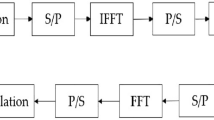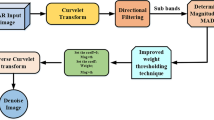Abstract
Orthogonal frequency division multiplexing (OFDM) has been investigated for the high-speed transmission of data in radio frequency and optical wireless communications. The OFDM systems usually experience high amplitude variations called peak-to-average power ratio (PAPR). The high PAPR makes non-linear distortion and performance degradation because of clipping the signal. To alleviate the high PAPR, we introduce a new technique based on the compressive sensing approach. In the offered method, the OFDM signal is compressed in the time domain and then transmitted. At the receiver, a G-LASSO (group least absolute shrinkage and selection operator) recovery algorithm is applied to reconstruct the original signal. The reconstruction accuracy of the suggested G-LASSO algorithm is compared with the original LASSO algorithm. Numerical results indicate the effectiveness of the offered approach in terms of PAPR reduction and bit error rate performance.







Similar content being viewed by others
References
Prasad, R. (2004). OFDM for wireless communications systems. Norwood: Artech House.
Sandoval, F., Poitau, G., & Gagnon, F. (2017). Hybrid peak-to-average power ratio reduction techniques: Review and performance comparison. IEEE Access, 5, 27145–27161.
Trivedi, V. K., Ramadan, K., Kumar, P., Dessouky, M. I., & Abd El-Samie, F. M. (2019). Enhanced OFDM-NOMA for next generation wireless communication: A study of PAPR reduction and sensitivity to CFO and estimation errors. AEU-International Journal of Electronics and Communications, 102, 9–24.
Anoh, K., Tanriover, C., & Adebisi, B. (2017). On the optimization of iterative clipping and filtering for PAPR reduction in OFDM systems. IEEE Access, 5, 12004–12013.
Jiang, T., Zhu, G., & Zheng, Jianbin. (2004). Block coding scheme for reducing PAPR in OFDM systems with large number of subcarriers. Journal of Electronics, 21(6), 482–489.
Jiang, T., Xiang, W., Richardson, P. C., Daiming, Q., & Zhu, Guangxi. (2007). On the nonlinear companding transform for reduction in PAPR of MCM signals. IEEE Transactions on Wireless Communications, 6(6), 2017–2021.
Wong, K. T., Wang, B., & Chen, J.-C. (2011). OFDM PAPR reduction by switching null subcarriers and data-subcarriers. Electronics letters, 47(1), 62–63.
Mehdi Hosseinzadeh Aghdam and Abbas Ali Sharifi. (2019). PAPR reduction in OFDM systems: An efficient PTS approach based on particle swarm optimization. ICT Express, 5(3), 178–181.
Abbas Ali Sharifi and Mehdi Hosseinzadeh Aghdam. (2019). A novel hybrid genetic algorithm to reduce the peak-to-average power ratio of OFDM signals. Computers & Electrical Engineering, 80, 106498.
Mohammady, S., Sidek, R. M., Varahram, P., Hamidon, M. N., & Sulaiman, N. (2013). A low complexity selected mapping scheme for peak to average power ratio reduction with digital predistortion in OFDM systems. International Journal of Communication Systems, 26(4), 481–494.
Seyyed, H. S., Masoumian, M. S., & Tazehkand, B. M. (2012). A new PAPR reduction method based on clipping technique using compressive sensing. In 6th International Symposium on Telecommunications (IST), pp. 238–242. IEEE.
Al-Safadi, E. B., & Al-Naffouri, Tareq Y. (2012). Peak reduction and clipping mitigation in OFDM by augmented compressive sensing. IEEE Transactions on Signal Processing, 60(7), 3834–3839.
Abbas Ali Sharifi. (2019). Discrete Hartley matrix transform precoding-based OFDM system to reduce the high PAPR. ICT Express, 5(2), 100–103.
Abbas Ali Sharifi. (2019). A new post-coding approach for PAPR reduction in dc-biased optical OFDM systems. Optoelectronics Letters, 15(4), 302–305.
Jiang, T., & Yiyan, Wu. (2008). An overview: Peak-to-average power ratio reduction techniques for OFDM signals. IEEE Transactions on broadcasting, 54(2), 257–268.
Rahmatallah, Y., & Mohan, Seshadri. (2013). Peak-to-average power ratio reduction in OFDM systems: A survey and taxonomy. IEEE Communications Surveys & Tutorials, 15(4), 1567–1592.
Jerome, F., Trevor, H., & Tibshirani, R. (2010). A note on the group lasso and a sparse group lasso. arXiv preprint arXiv:1001.0736.
Lv, X., Bi, G., & Wan, C. (2011). The group lasso for stable recovery of block-sparse signal representations. IEEE Transactions on Signal Processing, 59(4), 1371–1382.
Zhi-Jie, L., Yuan-Xiang, L., Feng, W., Fei, Y., & Zheng-Long, X. (2014). Efficient and accelerated online learning for sparse group lasso. In 2014 IEEE International Conference on Data Mining Workshop, pp. 1171–1177. IEEE.
Azarnia, G., Tinati, M. A., & Rezaii, T. Y. (2017). Cooperative and distributed algorithm for compressed sensing recovery in WSNs. IET Signal Processing, 12(3), 346–357.
Shiri, H., Tinati, M. A., Codreanu, M., & Azarnia, G. (2018). Distributed sparse diffusion estimation with reduced communication cost. IET Signal Processing, 12(8), 1043–1052.
Azarnia, G., Tinati, M. A., & Rezaii, T. Y. (2019). Generic cooperative and distributed algorithm for recovery of signals with the same sparsity profile in wireless sensor networks: A non-convex approach. The Journal of Supercomputing, 75(5), 2315–2340.
Balas Kausik Natarajan. (1995). Sparse approximate solutions to linear systems. SIAM Journal on Computing, 24(2), 227–234.
Chen, S. S., Donoho, D. L., & Saunders, M. A. (2001). Atomic decomposition by basis pursuit. SIAM Review, 43(1), 129–159.
Tibshirani, Robert. (1996). Regression shrinkage and selection via the lasso. Journal of the Royal Statistical Society: Series B (Methodological), 58(1), 267–288.
Yuan, Ming, & Lin, Yi. (2006). Model selection and estimation in regression with grouped variables. Journal of the Royal Statistical Society: Series B (Statistical Methodology), 68(1), 49–67.
Author information
Authors and Affiliations
Corresponding author
Additional information
Publisher's Note
Springer Nature remains neutral with regard to jurisdictional claims in published maps and institutional affiliations.
Rights and permissions
Springer Nature or its licensor holds exclusive rights to this article under a publishing agreement with the author(s) or other rightsholder(s); author self-archiving of the accepted manuscript version of this article is solely governed by the terms of such publishing agreement and applicable law.
About this article
Cite this article
Azarnia, G., Sharifi, A.A. Performance improvement of OFDM systems using compressive sensing with group LASSO signal reconstruction algorithm. Wireless Netw 28, 3771–3778 (2022). https://doi.org/10.1007/s11276-022-03080-z
Accepted:
Published:
Issue Date:
DOI: https://doi.org/10.1007/s11276-022-03080-z




